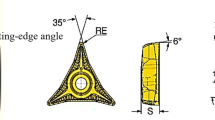Abstract
In this paper, the influences of cutting speed, depth of cut, feed, workpiece hardness (51, 55, 58, 62, and 65 ± 1 HRC), and nose radius on surface integrity in finish dry hard turning (FDHT) of the hardened tool steel AISI D2 by utilizing the polycrystalline cubic boron nitride (PCBN) inserts were experimentally investigated. Experimental results showed that the ploughing effect, serious squeeze, and elastic deformation have more significant on the surface roughness than those black fusion welding materials and side flows, and the surface roughness values are in the range of 0.34–0.86 μm between 150- and 301-m/min cutting speeds and totally attains a surface finish of grinding. The surface roughness is not very sensitive to the depth of cut in the range from 0.10 to 0.25 mm. The “residual cutting” materials, material plastic deformation, and even cohesion in the machined surface and cold welding effect do occur and hence influence on the surface integrity. The tiny grooves, severe plastic flow, and extensive material flows at lower feeds have significant influence on the surface integrity. The subsurface damages produced by the turning process also do occur and become severer at the larger feeds due to the localized stretch, plastic deformation, and even dilacerations of subsurface material induced by the friction from the tool flank face. The thermal softening, serious material side flows, and squeezing have significant effect on surface integrity when FDHT of the hardened tool steel AISI D2 at different hardness levels. And the heat effect is greater than the geometry effect as the nose radius attains a certain value.
Similar content being viewed by others
References
Meyer R, Köhler J, Denkena B (2012) Influence of the tool corner radius on the tool wear and process forces during hard turning. Int J Adv Manuf Technol 58(9–12):933–940
Yong H, Liang SY (2004) Modeling of CBN tool flank wear progression in finish hard turning. ASME J Manuf Sci Eng 126:98–106
Klocke F, Brinksmeier E, Weinert K (2005) Capability profile of hard cutting and grinding processes. Ann CIRP 54(2):552–580
Tang L, Huang J, **e L (2011) Finite element modeling and simulation in dry hard orthogonal cutting AISI D2 tool steel with CBN cutting tool. Int J Adv Manuf Technol 53(9/12):1167–1181
Tang L, Gao C, Huang J, Lin X, Zhang J (2013) Experimental investigation of the three-component forces in finish dry hard turning of hardened tool steel at different hardness levels. Int J Adv Manuf Technol 70(9–12):1721–1729
Meye R, Köhler J, Denkena B (2011) Influence of the tool corner radius on the tool wear and process forces during hard turning. Int J Adv Manuf Technol 58(2012):933–940
Gaitonde VN, Karnik SR, Figueira L, Figueira L, Paulo Davim J (2011) Performance comparison of conventional and wiper ceramic inserts in hard turning through artificial neural network modeling. Int J Adv Manuf Technol 52:101–114
Thiele JD, Melkote SN (1999) Effect of cutting edge geometry and workpiece hardness on surface generation in the finish hard turning of AISI 52100 steel. J Mater Process Technol 94:216–226
Rech J, Moisan A (2003) Surface integrity in finish hard turning of case-hardened steels. Int J Mach Tool Manuf 43:543–550
Ozel T, Hsu TK, Zeren E (2005) Effects of cutting edge geometry, workpiece hardness, feed rate and cutting speed on surface roughness and forces in finish turning of hardened AISI H13 steel. Int J Adv Manuf Technol 25:262–926
Umbrello D, Jawahir I (2009) Numerical modeling of the influence of process parameters and work- piece hardness on white layer formation in AISI 52100 steel. Int J Adv Manuf Technol 44:955–968
Okada M, Hosokawa A, Tanaka R, Ueda T (2011) Cutting performance of PVD-coated carbide and CBN tools in hardmilling. Int J Mach Tool Manuf 51:127–132
Rech J, Moisan A (2013) Surface integrity in finish hard turning of case-hardened steels. Int J Adv Manuf Technol 43:543–550
Aouici H, Yallese MA, Chaoui C, Mabrouki T, Rigal JF (2012) Analysis of surface roughness and cutting force components in hard turning with CBN tool: Prediction model and cutting conditions optimization. Measurement 45:344–353
Chen T, Li SY, Han BX, Liu GJ (2014) Study on cutting force and surface micro-topography of hard turning of GCr15 steel. Int J Adv Manuf Technol 9–12:1639–1645
Zhou AQ, Deng FY (2001) Experimental study on the heat treatment process for Cr12MoV steel. Die Mould Ind 000:55–57
Wang LJ, Miao B, Meng XX (2005) Analysis on the hardness and metallographic structure of Cr12MoV Steel under different heat treatment. Die Mould Ind 000:2–56
Dogra M, Sharma VS, Sachdeva A, Suri NM, Dureja JS (2010) Tool wear, chip formation and workpiece surface issues in CBN hard turning: a review. Int J Precis Eng Manuf 11(2):341–358
Liu Z, Zhou J, Wan Y (2006) Tool materials for high speed machining and their fabrication technologies. Mater Mech Eng 30(5):1–4
Pang JZ, Wang MJ, Duan CZ (2009) Surface roughness in high-speed side milling of hardened mold steel. J Dalian Univ Technol 49:216–221
Xu J (2009) Study on high speed cutting hardened steel with the coated insert (CN35). South China University of Technology, Dissertation
Fernández-Abia AI, Barreiro J, López de Lacalle LN, Martínez S (2011) Effect of very high cutting speeds on shearing, cutting forces and roughness in dry turning of austenitic stainless steels. Int J Adv Manuf Technol 57:61–69
Kishawy H, Elbestawi M (1999) Effects of process parameters on material side flow during hard turning. Int J Mach Tool Manuf 39:1017–1030
Al-Ahmari AMA (2007) Predictive machinability models for a selected hard material in turning operations. J Mater Process Technol 190:305–311
Author information
Authors and Affiliations
Corresponding author
Rights and permissions
About this article
Cite this article
Tang, L., Gao, C., Huang, J. et al. Experimental investigation of surface integrity in finish dry hard turning of hardened tool steel at different hardness levels. Int J Adv Manuf Technol 77, 1655–1669 (2015). https://doi.org/10.1007/s00170-014-6484-1
Received:
Accepted:
Published:
Issue Date:
DOI: https://doi.org/10.1007/s00170-014-6484-1



